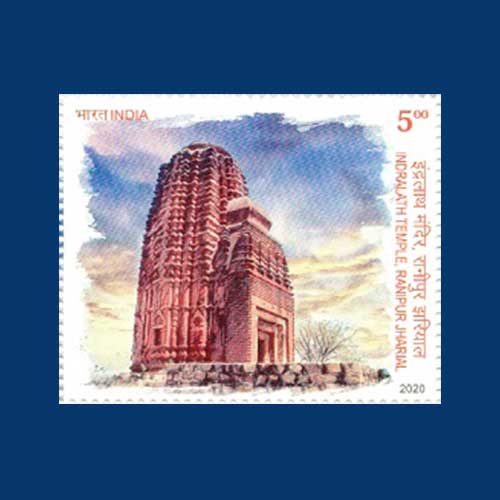Fascinating Archaeological Facts on Postage Stamps - 85
2025-08-11 Mon
Terracotta, or baked Clay, has been utilized continuously since prehistoric times, making it one of the oldest Building materials known to Humanity. The application of terracotta has evolved over the centuries, transitioning from the creation of everyday objects, such as vessels, pottery, toys, and seals, to its significant role in Temple construction.A notable example of this evolution is the Indralatha Temple, recognized as the tallest brick temple in Odisha. Dedicated to Lord Shiva, it is situated near Ranipur-Jharial in the Balangir district. The temple is constructed from bricks, with its sikhara soaring over 80 feet. It stands over a stone platform made of granite blocks. The architectural composition of the temple, from the pabhaga (the base or plinth, specifically the lowest section of the bada or main vertical wall) to the mastaka (the pinnacle of the temple’s superstructure), is crafted using burnt bricks that have been mixed with rice husk. Some scholars propose that the temple was originally a Vaishnava temple before being converted to a Shiva temple.
The identity of the builders and the precise date of construction of this temple remain subjects of scholarly #debate. Researchers Beglar and Williams suggest a date in the 7th century CE, postulating that the temple serves as a prototype for the Lakshmana Temple located in Sirpur, Chhattisgarh. For more insights on the Lakshmana Temple, refer to This Post
Dr. C.B. patel, in his work "Monumental Efflorescence of Ranipur-Jharial" (2004), attributes the temple to the nala rulers of the 7th century CE, who were followers of Vaishnavism and ruled parts of present-day Chhattisgarh and Odisha. Notably, the Indira Gandhi National Centre for the Arts (IGNCA) dates the temple to the 10th or 11th centuries CE, attributing it to the Somavamsi dynasty.
Dr. N. Seth, in "Ranipur Jharial: The Most Notable Monument in Western Odisha" (2018), provides a detailed description of the temple. The platform measures more than 90 feet long and 37 feet wide. Built in the South Kosala style, this temple follows a Pancharatha plan. The jagamohana (assembly hall) has not survived, leaving only the deula and the antarala. The garbhagriha houses a linga but also features images of Lord Vishnu, Kartikeya, and Maheshvara. The garbhagriha is supported by four pillars placed at each corner, and the ceiling is adorned with carved lotus flowers—one in the garbhagriha and another in the antarala. The temple is decorated with sculptural motifs, including narasimha, Nataraja, etc., as well as architectural designs such as naga-nagi pilasters on the outer walls.
On 08 August 2020, #India Post issued a set of 7 Stamps and a miniature Sheet dedicated to the Terracotta Temples of India, which notably included the Indralatha Temple, valued at Rs 5.
Latest News
-
Ghiyath Shah as Heir Apparent
2025-09-25 ThuGhiyath Shah was the ruler of the Malwa Sultanate, reigning from 1456 to 1500. From 1456 to 1469, he...
-
Malwa Sultan Mahmud Shah Silver Coins
2025-09-11 ThuMalwa Sultan Mahmud Shah minted silver coins in round and square flans. <br><br> For round coins,...
-
Malwa Sultan Mahmud Shah Billon coin
2025-08-26 TueMalwa Sultan Mahmud Shah's billon coins followed three weight standards: 100 rati, 96 rati, and 80 r...
-
Fascinating Archaeological Facts on Postage Stamps - 91
2025-08-23 SatRhinoceros is one of the oldest land mammal species existing in India. There are five species of rhi...
-
Fascinating Archaeological Facts on Postage Stamps - 90
2025-08-23 SatUthiramerur, a Village in Kanchipuram, Tamil Nadu, is notable for its Temple inscriptions that descr...

